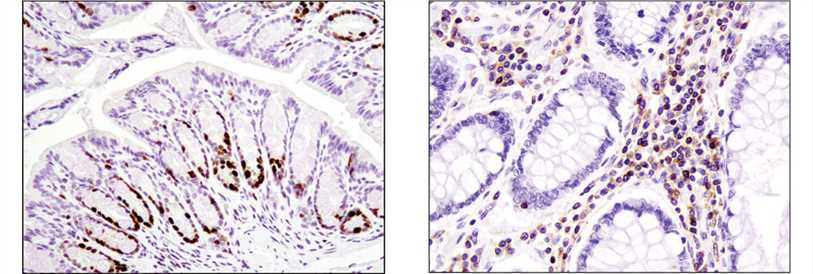Immunohistochemistry Troubleshooting
Immunohistochemistry is a complex experiment with multiple parameters that need to be considered and optimized. The following troubleshooting guides are intended to explain the causes and possible solutions for common problems in immunohistochemistry/immunofluorescence (IHC/IF) staining.

No Staining
| Possible Problems | Recommended Solution(s) |
| Inadequate or excessive tissue fixation | Try increasing the fixation time or try a different fixative. Reduce the duration of the immersion or post-fixation steps. If immersion-fixation cannot be avoided (e.g. collection of postmortem tissues or biopsies in pathology lab), antigens may be unmasked by treatment with antigen retrieval reagents. |
| Epitope altered during fixation or embedding procedure | Try different antigen retrieval methods to restore immunoreactivity. Embed tissue at 58°C or below. |
| Insufficient deparaffinization | Extend the deparaffinization time and replace with fresh xylene. |
| Lack of antigen or insufficient | Run a positive control or use an amplification step to maximize the signal. |
| Antigen retrieval was ineffective | Increase the time of treatment or change the treatment solution. |
| Not enough primary antibody | Increase the concentration of primary or secondary antibodies. Incubate for longer periods of time (e.g. overnight) at 4°C. |
| Incompatible secondary and primary antibodies | Use a secondary antibody that was raised against the species in which the primary was raised (e.g. primary is raised in rabbit, use anti-rabbit secondary). |
| Antibodies do not work due to improper storage | Follow storage instructions on the datasheet. In general, aliquot antibodies into smaller volumes sufficient to make a working solution for a single experiment. Store aliquots in a freezer (-20 to -70°C) and avoid repeated freeze-thaw cycles. |
Inappropriate Staining
| Possible Problems | Recommended Solution(s) |
| Fixation method is inappropriate for the antigen | Try a different fixative or increase the fixation time. |
| Antigen retrieval may be inappropriate for this antigen or tissue | Try different antigen retrieval conditions. |
| Electrostatic charge of the antigen has been altered | Try adjusting the pH or cation concentration of the antibody diluent. |
| Delay in fixation caused diffusion of the antigen | Fix tissue promptly. Try a cross-linking fixative rather than organic (alcohol) fixative. |
High Background
| Possible Problems | Recommended Solution(s) |
| High concentration of primary and/or secondary antibodies | Titer antibody to determine optimal concentration needed to promote a specific reaction of the primary and the secondary antibodies. |
| Non-specific binding of primary and/or secondary reagents to tissues | Use blocking step just prior to primary antibody incubation (we recommend blocking with 10% normal serum for 1 h for sections or with 1-5% BSA for 30 min for cells). |
| Non-specific binding of secondary antibody | Run a secondary control without primary antibody. |
| Tissue dried out | Avoid letting the tissue dry during the staining procedure. |
| Active endogenous peroxidases | Use enzyme inhibitors (e.g. Levamisol (2 mM) for alkaline phosphatase or H2O2 (0.3-3% v/v) for peroxidase). |
Cell Services
Histology Services